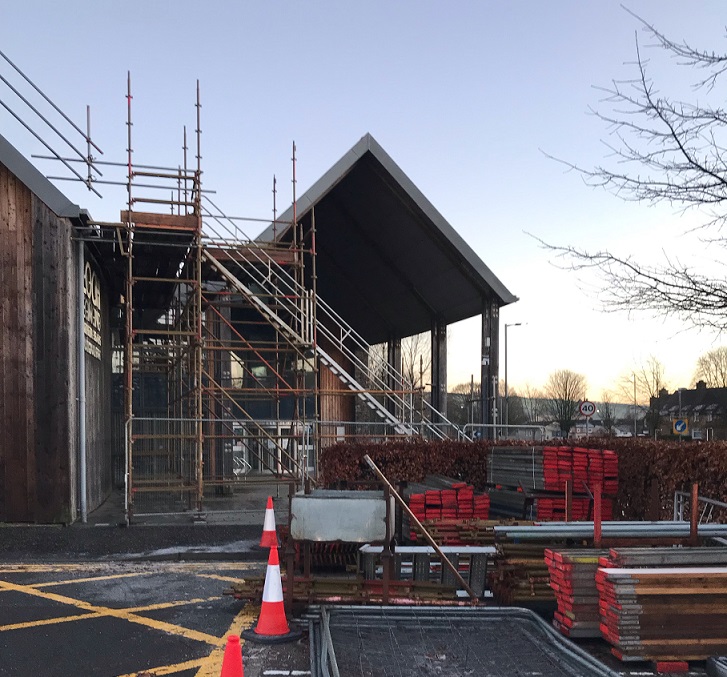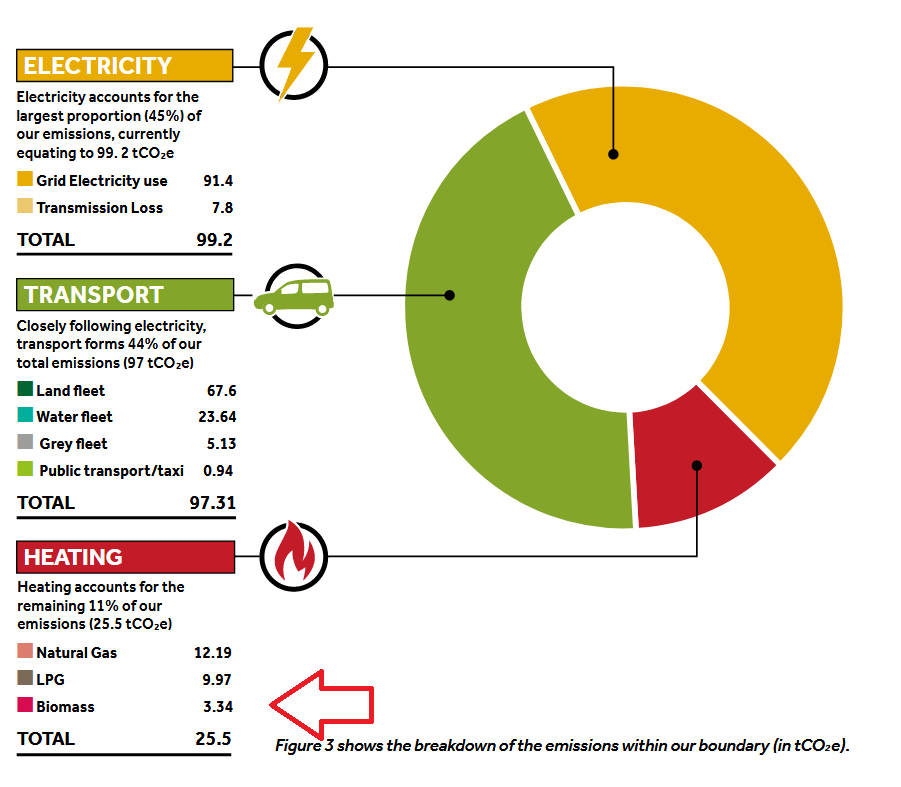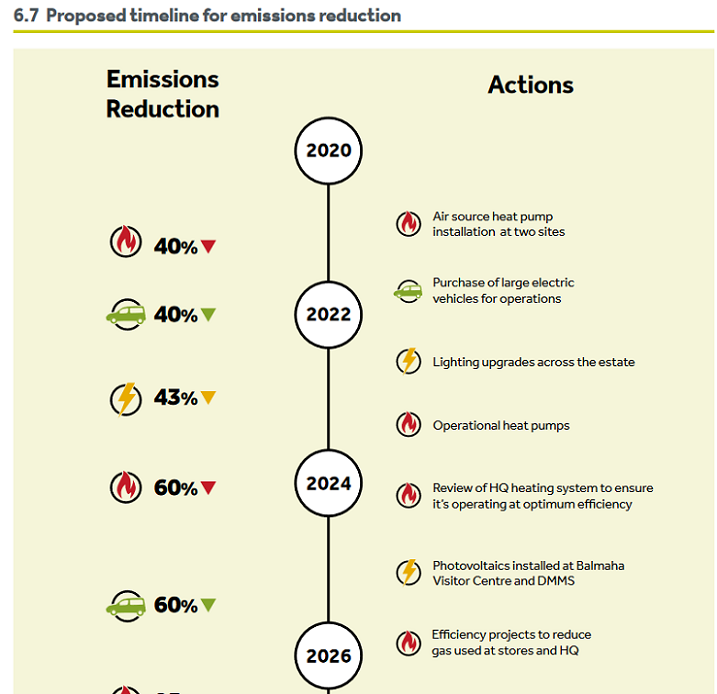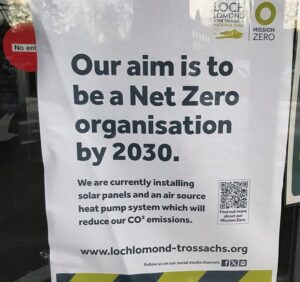
Temperatures in Scotland on Sunday reached a UK record of 19.6 degrees at Kinlochewe in Torridon. There is an excellent short blog and photos showing the impact on the Scottish Avalanche Information Service website (see here). While the temperature spike is explained by the foehn effect (see here), it still beats previous heat records in what historically has been the coldest month of the year in Scotland. It provides yet another warning that the richer countries in the world need to reduce their use of fossil fuels and rapidly.
National Parks can only make a tiny contribution to this. Unfortunately, at present not only are they not doing enough, often they are making matters worse. Two examples are the Cairngorms National Park Authority’s tacit acceptance of BrewDog’s disastrous forest (see here) and the Loch Lomond and Trossachs National Park Authority (LLTNPA)’s promotion of extra car parking places before green transport at Tarbet (see here).
While we need to stop the greenwashing if we are tackle the climate and nature emergencies, getting green investment right is actually very complicated as anyone who has considered retrofitting their home to make it more energy efficient will know. This post will consider the LLTNPA’s current work to retrofit its Headquarters, Carrochan, which is claims (see here) will help it attain net zero as an organisation by 2030.
Carrochan – designed as a sustainable building heated by biomass
Six years after the creation of the LLTNPA, a new purpose built headquarters named Carrochan was opened in Balloch in 2008 which was intended to exemplify sustainability:
“Sustainability was critical for the Park Headquarters; the building is well insulated and constructed to be largely air-tight. The services are designed to be energy efficient. A biomass boiler, fuelled by woodchips from Argyll is used for heating and hot water. The building is naturally ventilated with automatically opening windows linked to the building management system that regulates the air temperature. To the rear of the building a reed bed area forms part of the sustainable drainage system for the headquarters. The building achieved an Excellent BREEAM Rating of 79% at the design stage, this supported the principal expectation of the National Park that project would be an exemplar of sustainable design and demonstrate that low CO2 producing buildings can be functional as well as beautiful” (see here).
The new building won a host of design awards (see here) including the Carbon Trust Low Carbon Building Award 2009 and the Scottish Design Awards 2009, Engineering Design Award and Sustainability Award. In reality, Carrochan was probably never as “sustainable” as all these awards suggested, with heat for example spotted leaking out the roof soon after construction(see here).
The building included a biomass heating system. This was potentially carbon neutral, provided that new trees replaced the wood it consumed and the woodchips weren’t dried or transported to Balloch with energy generated by fossil fuels. It also provided an opportunity for the LLTNPA to work with Forest and Land Scotland to demonstrate how all the timber wasted by industrial forest practices in the National Park could be put to better use.
Information from the LLTNPA’s Net Zero Route Map published in January 2021 (see here) suggested that the biomass boiler had been a remarkably successful means of reducing carbon emissions:

As a result the priority in the Net Zero plan was “the replacement of LPG and natural gas heating systems” with air source heat pumps, starting with the Balmaha Visitor Centre and the Duncan Mills Memorial Slipway. The justifications for choosing air source heat pumps over biomass or other types of heat pumps – there is a huge project to generate heat from the Clyde so why not Loch Lomond – was not explained in the Route Map. With the Duncan Mills Slipway close to Carrochan the potential to save on biomass fuel deliveries appears not to have been considered. And if biomass was discounted because of its impact on air pollution, why not say so?
Setting aside these questions, the LLTNPA Board agreed a timetable which included installation of two air source heat pumps in 2021 and a review of the heating system at Carrochan to make it more efficient in 2024:

Why is the biomass boiler being replaced with an air source heat pump?


In November the LLTNPA published two contract awards notices, the first to install solar panels on the roof at Carrochan (hence the scaffolding) and the second for the installation of an air source heat pump:

The award notice shows there were two bids to install and the LLTNPA awarded the contract to a local firm who submitted the lowest bid £573,445 (see here). A news release from the LLTNPA (see here) shows that this is being funded by a grant from the Scottish Government’s Public Sector Heat Decarbonisation Fund (£1,129,200) which will also cover the cost of the (delayed) work to install heat pumps at the Balmaha Visitor Centre and Duncan Mills Memorial Slipway and installation of solar panels at the Loch Chon campsite.
As far as I have been able to ascertain the LLTNPA has never explained in public what went wrong with its “sustainable” biomass heating system, although it appears that it may have broken down or been supplemented by gas. One possible explanations for the change of plans/timetable therefore is that the Scottish Government had a wad of unspent capital cash available and LLTNPA staff decided to grab it as a means of resolving problems with the biomass heating system. It was also possibly seen as a way to lend support to the Scottish Government’s air source heat programme, which appears to be in trouble/behind schedule, and curry favour as a consequence.
Whether retrofitting Carrochan with an air source heat pump at a cost of £573,445, however, represents good value for money or is the best way to for the LLTNPA to reduce its carbon emissions deserves a public answer:
From a purely financial perspective replacing one heating system with another costing £573,445 in less than 15 years appears the opposite of sustainability and deserves to be considered by Audit Scotland. If the biomass boiler needed to be replaced, doing so would have cost a lot less than £573,445, so why replace the whole system.
The policy U-turn on biomass for heating has never been approved in public by the LLTNPA Board. As recently as February 2022 the LLTNPA advertised a contract worth £34k (see here) for the supply of woodchip to Balloch. That, taken with the 2020 announcement (see here) that it had provided the Trossachs Community Trust with a £20k grant to install a “renewable (biomass) heating and hot water supply”, shows that until very recently the LLTNPA appears to have been all in favour of biomass.
There are a number of other important questions raised by the LLTNPA’s decision to install a heat pump:
- What will the impact on the carbon emissions of LLTNPA as an organisation be of using a heat pump rather than a biomass boiler given that a significant proportion of the electricity required to operate heat pumps, particularly in the coldest periods, will remain dependant on fossil fuels for the likely lifetime of the new pumps? If the LLTNPA truthfully reports on this, I would expect its carbon emissions to increase not decrease as the solar panels it is installing will generate very little electricity in winter when heating is needed.
- Why has the LLTNPA chosen an air source heat pump when ground source heat pumps are generally more efficient? There is a lot of ground around Carrochan where it would be easy to drills holes into the earth for a ground source heat pump, something that is difficult in most urban areas. There would have also been opportunities for a district heating system which would supply other houses/businesses?
- Is the insulation at Carrochan now good enough to enable efficient use of a heat pump? If so, are there not other leakier buildings in the National Park which would have benefitted more from the Scottish Government’s £573,445 investment?
Getting green investment right
As I stated at the start of this post, getting decisions about how to reduce carbon emissions right is difficult. The history of the biomass boiler at Carrochan possibly provides an illustration of that: unfortunately, if it was such a bad mistake, the LLTNPA has not explained why or made public any of the lessons that could be learned from this.
It is also possible that the LLTNPA has considered the issues I have raised about biomass boilers v heat pumps. If so, why have they not been set out in a public paper to their board?
The LLTNPA has claimed that by developing its Net Zero Mission map it is showing a lead to others in the National Park. That is easily said by an organisation which is bankrolled by the Scottish Government and pays little or no attention to whether investments represent good value. But this unexplained U-turn on heating leaves that claim in tatters.
As the LLTNPA chops and changes course with the political wind, the far more important questions about what would be the best ways for the rural homes and businesses in the National Park to reach net zero and how this should be resourced have not even been asked. What is clear is that no-one in their right senses should follow the “lead” of the LLTNPA when it comes to green investment. The Minister responsible for National Parks, the Green MSP Lorna Slater, needs to be aware that what has happened at the LLTNPA risks giving green investment a bad name at a time when it is needed as never before.
In my view the best way to avoid those risks is to ensure the LLTNPA operates openly and transparently, is subject to public scrutiny and takes decisions in public. Lorna Slater could ask the LLTNPA Board to take a step in the direction by setting up a resources committee which would deal with all issues relating to investment in and management of its property including how best to reduce carbon emissions.
4-5 years ago, it was common practice at Carrochan to go to work on Monday mornings with overcoats and the rest, as the biomass system was still warming the building up after the weekend. LLTNP employees openly joked about and mildly criticised the heating system for failing to provide a warm workplace. So, more questions about efficacy and effectiveness of the original capital spend.
£573,000 for a new heat pump in a relatively small office building is an eye-wateringly large sum of taxpayers’ money to spend. This would never have been sanctioned in a commercial property situation. Quite remarkable. What was the LLTNP Board view of all this?
Further costs, by way of inefficiency, have been incurred with the office closed since early November 2023, resulting in more than three months of staff working from home and failing to communicate efficiently. Again, this would not have happened in the private sector.
LLTNP management need to be held accountable for their spending, yet it seems that the Board and ScotGov have failed in this basic matter of good governance.